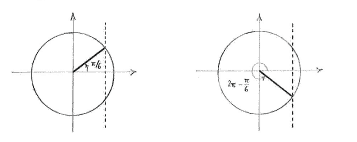Lösung 4.4:3a
Aus Online Mathematik Brückenkurs 1
(Unterschied zwischen Versionen)
K |
K (Robot: Automated text replacement (-{{Displayed math +{{Abgesetzte Formel)) |
||
| Zeile 7: | Zeile 7: | ||
We obtain all solutions to the equation if we add multiples of <math>2\pi</math> to the two solutions above, | We obtain all solutions to the equation if we add multiples of <math>2\pi</math> to the two solutions above, | ||
| - | {{ | + | {{Abgesetzte Formel||<math>x = \frac{\pi}{6} + 2n\pi\qquad\text{and}\qquad x = \frac{11\pi}{6} + 2n\pi\,,</math>}} |
where ''n'' is an arbitrary integer. | where ''n'' is an arbitrary integer. | ||
Version vom 08:58, 22. Okt. 2008
The right-hand side of the equation is a constant, so the equation is in fact a normal trigonometric equation of the type \displaystyle \cos x = a\,.
In this case, we can see directly that one solution is \displaystyle x = \pi/6\,. Using the unit circle, it follows that \displaystyle x = 2\pi - \pi/6 = 11\pi/6\, is the only other solution between \displaystyle 0 and \displaystyle 2\pi\,.
We obtain all solutions to the equation if we add multiples of \displaystyle 2\pi to the two solutions above,
| \displaystyle x = \frac{\pi}{6} + 2n\pi\qquad\text{and}\qquad x = \frac{11\pi}{6} + 2n\pi\,, |
where n is an arbitrary integer.

